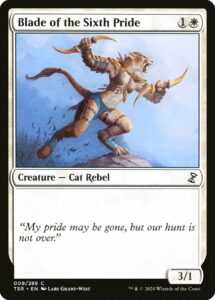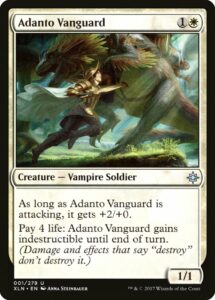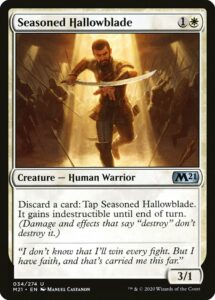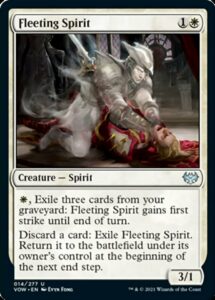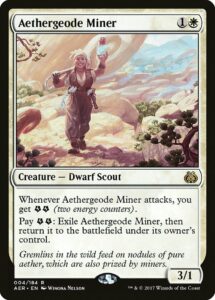For more than half of Magic’s history, white has gotten 3/1s for two mana. First, there was Blade of the Sixth Pride, but within a few years, we saw 3/1s with upside like Accorder Paladin, Daring Skyjek, and Spirit of the Labyrinth. But within this group, there’s a very small club of which Fleeting Spirit is the third member. It joins Adanto Vanguard and Seasoned Hallowblade as 1W 3/1s that refuse to die.
This small group of creatures is fascinating in the diverse ways they answer a pretty complex design challenge. How can you make resilient, aggressive creatures without making the game miserable? Unkillable creatures are inherently problematic. They negate entire classes of removal, can be overly powerful on defense (bogging the game down), and lead to uninteractive games. These three cards in particular require no mana to protect themselves, meaning they present no ‘shields down’ moments where they’re vulnerable to disruption.
Today, we’re going to examine each one of these to see how they answers the aforementioned question, the advantages of their design, and their potential pitfalls.
Commonalities
To start, let’s look at what all of these creatures have in common. A 3/1 for two mana isn’t especially impressive on its own, but it applies pressure very effectively, especially alongside other aggressive creatures. The trouble is that one toughness makes them extremely vulnerable. They trade with every creature, fall to every removal spell, are awful against tokens, and get blanked by midsized creatures.
A protection ability upends the calculus by (mostly) eliminating the weakness of one toughness. Make the creature resilient against removal and your opponent has to engage in combat, making life much harder for control players. Make the creature resilient in combat and your opponent will have a hard time blocking it profitably. If blocking doesn’t work, you push your opponent into racing you, but it’s hard to profitably race a three power two drop. The protection effect magnifies the effectiveness of your creature’s power by circumventing the weakness of one toughness.
These creatures force your opponent to respond, and the best tools are playing bigger creatures or using specialized removal. They make it harder for uninteractive control and combo decks to ignore or invalidate what you do and encourage decks to play more creatures, things which generally lead to better gameplay. These creatures perform a valuable service by applying pressure to an entire format. Though things can go wrong if they succeed at this task too well (or there aren’t enough tools to deal with them).
Tight focus, low cost
Adanto Vanguard was an outstanding aggressive threat and the only card discussed today to have a serious impact on Standard. Much of this is due to it having the lowest cost to protect itself. It demands life, the most abundant resource at the start of every game, and one which aggressive decks player to have far more of than their opponents. Accordingly, the cost of activating Adanto Vanguard is low. So low, in fact, it was occasionally advantageous to activate it purely to trigger your own Knight of the Ebon Legion. In addition, there’s no penalty for this protection, whereas Fleeting Spirit and Seasoned Hallowblade can be hindered by protecting themselves.
The cost, of course, is steep. Adanto Vanguard is only effective on offense. A 1/1 for two is hardly playable, and paying four life is unlikely to prevent much damage to you from an attacking creature. Adanto Vanguard has very little modality—it is designed to attack every turn, with a constant threat of activation, and the first three activations generally have a minimal cost (and provide value every time). There is a lot of play to the card between the mind games, synergy, and utility of indestructibility, but Adanto Vanguard may well be a tad over the line for current Magic with how difficult it can be to play against.
Simplicity
Seasoned Hallowblade hails from a core set, and so is a delightfully straightforward and powerful card. Its protection ability is the same as Adanto Vanguard‘s—becoming indestructible—but has larger costs. Discarding a card is generally more expensive than paying life, especially when as the aggressor your life total tends not to matter.
While Adanto Vanguard could generate card advantage by trading 4 life for your opponent’s creature or removal spell, Seasoned Hallowblade‘s indestructibility is card advantage neutral. In addition, your opponent can use a removal spell to prevent an attack, since Seasoned Hallowblade‘s protection taps it. All this makes the protection ability appreciably weaker. Of course, there’s a benefit to the Hallowblade. He can block very well.
This versatility is ultimately what makes Seasoned Hallowblade weaker than the more focused Adanto Vanguard. His ability to play defense makes racing even harder for your opponent, but being defensive gives your opponent time to find bigger creatures that can invalidate him. Adanto Vanguard‘s protection allowed it to make use of its three power every turn, while holding Seasoned Hallowblade back merely threatens dealing three damage, handing the decision to your opponent.
All told, I really like Seasoned Hallowblade‘s design. I think the play pattern is better, as he doesn’t generate easy card advantage but can be a huge thorn in your opponent’s side (and played extremely well with Rousing Read). Yes, it’s a weaker card than Adanto Vanguard, but power and fun aren’t directly correlated (from a design perspective). One of these days, I’m going to use Seasoned Hallowblade as an aggressive Madness enabler (which admittedly will be a challenge given that there are hardly any white Madness spells), and employing that oblique modality is going to make my week.
Flexibility and complexity
Fleeting Spirit splits its protection into two different abilities: first strike to protect it in combat and blinking to protect it from spells. This makes for a very different experience than Seasoned Hallowblade and Adanto Vanguard with their singular costs and protective effects.
For starters, first strike requires two input resources, one of which (a stocked graveyard) is in short supply at the start of the game (especially for white decks), so Fleeting Spirit has ‘shields down’ moments. Moreover, first strike is weaker in combat than indestructible. Flickering is generally more protective than indestructible, though it’s a purely defensive ability that cannot be leveraged offensively.
There’s play to the card, but also awkwardness. There’s ostensibly synergy between the two abilities, though discarding cards to set up a first strike your opponent will see a mile away isn’t exactly enticing. Flickering can be used to enable pseudo-Vigilance, but it also knocks off the Disturb auras Fleeting Spirit would otherwise make great use of (having it phase out instead would swap this tradeoff).
Of course, there is the deeply satisfying setup I’ve done to a few opponents where they double block, you take out one blocker with first strike then flicker to jump out of combat. It’s a satisfying, Spike-y situation, but I’m not sure it speaks well to the design that it can be hard to predict exact what Fleeting Spirit is capable of even after reading it several times.
I wonder which of its predecessors the next 3/1 aggressive, self-protecting creature will resemble. An Adando Vanguard, where all its potency is focused in aggression seems unlikely, especially with white aggro gaining ample tools over the past year and cards like Luminarch Aspirant and Adeline, Resplendent Cathar making it easy to add value to such a threat. Seasoned Hallowblade is beautifully simple, but its elegance leaves minimal room for innovation and power proved too far below the curve. Fleeting Spirit provides a wealth of knobs for Play Design to adjust, but may have too many complicated interactions and is arguably weaker than Seasoned Hallowblade.
Perhaps we’ll see many more cards like Intrepid Adversary, Glory-Bound Initiate, and the even larger Sungold Sentinel—cards less defined by how they protect themselves—before we see another Vanguard or Hallowblade. There’s something be said for aspirational designs that promise proactive boons rather than defensive designs intended to stymie your opponent’s ability to react.Time will tell, and I’ll be glad to see every new step down this path.
Zachary Barash is a New York City-based game designer and the commissioner of Team Draft League. He designs for Kingdom Death: Monster, has a Game Design MFA from the NYU Game Center, and does freelance game design. When the stars align, he streams Magic (but the stars align way less often than he’d like).

